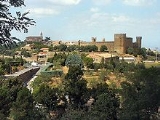
Montalcino
Encyclopedia
Montalcino is a hilltown and comune
in Tuscany
, Italy
. It is famous for its Brunello di Montalcino
wine
.
The town is located to the west of Pienza
, close to the Crete Senesi
in Val d'Orcia. It is 42 km from Siena
, 110 km from Florence
and 150 km from Pisa
. The Monte Amiata
is located nearby.
times. Its first mention in historical documents in 814 AD suggests there was a church here in the 9th century, most likely built by monk
s who were associated with the nearby Abbey of Sant'Antimo. The population grew suddenly in the middle of the tenth century when people fleeing the nearby town of Roselle
took up residence in the town.
The town takes its name from a variety of oak tree that once covered the terrain. The very high site of the town offers stunning views over the Asso, Ombrone and Arbia valleys of Tuscany
, dotted with silvery olive orchards, vineyards, fields and villages. The lower slopes of the Montalcino hill itself are dominated by highly productive vines and olive
orchards.
During medieval times the city was known for its tanneries and for the shoes and other leather goods that were made from the high quality leathers that were produced there. As time went by, many medieval hill towns, including Montalcino, went into serious economic decline.
Like many of the medieval towns of Tuscany, Montalcino experienced long periods of peace and often enjoyed a measure of prosperity. This peace and prosperity was, however, interrupted by a number of extremely violent episodes.
During the late Middle Ages it was an independent commune with considerable importance owing to its location on the old Via Francigena
, the main road between France
and Rome, but increasingly Montalcino came under the sway of the larger and more aggressive city of Siena
.
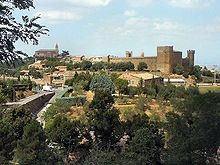 As a satellite of Siena since the Battle of Montaperti
As a satellite of Siena since the Battle of Montaperti
in 1260, Montalcino was deeply involved and affected by the conflicts in which Siena became embroiled, particularly in those with the city of Florence in the 14th and 15th centuries, and like many other cities in central and northern Italy
, the town was also caught up in the internecine wars between the Ghibellines (supporters of the Holy Roman Empire
) and the Guelphs (supporters of the Papacy). Factions from each side controlled the town at various times in the late medieval period.
Once Siena
had been conquered by Florence under the rule of the Medici
family in 1555, Montalcino held out for almost four years, but ultimately fell to the Florentines, under whose control it remained until the Grand Duchy of Tuscany
was amalgamated into a united Italy in 1861.
In the case of Montalcino, gradual economic decline has recently been reversed by economic growth due to the increasing popularity of the town's famous wine Brunello di Montalcino
, made from the sangiovese grosso grapes grown within the comune. The number of producers of the wine has grown from only 11 in the 1960s to more than 200 today, producing some 330,000 cases of the Brunello wine annually. Brunello was the first wine to be awarded Denominazione di Origine Controllata e Garantita (DOCG) status. In addition to Brunello di Montalcino, which must be aged five years prior to release, 6 years for the Riserva, Rosso di Montalcino (DOC), made from sangiovese grosso grapes and aged one year, and a variety of Super Tuscan wines are also produced within the comune, as well as the Moscadello sweet white wines for which it was most famous until the development of the Brunello series.
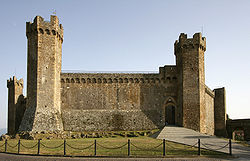
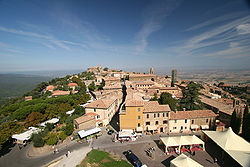
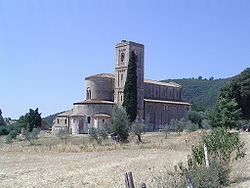
which now serves as the fortress chapel.Thought the town itself was eventually conquered, the fortress itself was never taken, an admirable feat, considering the size of the Sienese and Florentine forces that besieged Montalcino at varying intervals.
Down the narrow, short street that extends from the main gate of the fortress is the Chiesa di Sant'Agostino with its simple Romanesque
façade, also built in the 13th century.
The building adjacent to the church is a one-time convent, but it is now the home of the Musei Riuniti which is both a civic and diocesan museum. The museums hold various works, including a gorgeous wooden crucifix by an unknown artist of the Sienese school, two beautiful 15th century wooden sculptures, including one of an incredibly moving Madonna by an anonymous artist which has become the symbol of Montalcino on the various posters and pubblicity, and several other sculptures in terracotta which appear to be of the Della Robbia
school. The collection also includes a St Peter and St Paul by Ambrogio Lorenzetti
and a Virgin and Child by Simone Martini
. There are also more modern works from the beginning of the 20th century that offset and reflect the older works of art in the artful way they are presented by the curator.
The Duomo (cathedral), dedicated to San Salvatore
, was originally built in the 14th Century, but it now has a neo-classical appearance thanks to extensive renovation work that was done in the early 19th century under the direction of Sienese architect Agostino Fantasici.
originally the Piazza della Principessa Margherita, is down the hill from the fortress and Duomo on the via Matteotti. The principal building on the piazza is the town hall, once the Palazzo dei Priori (built late 13th, early 14th century) which was for many years the Palazzo Comunale. The palace is adorned with the coats of arms of the Podesta who once ruled the city. A very high medieval tower is incorporated into the palazzo. Close by is a Renaissance
structure with six round arches, called La Loggia, which was started at the very end of the 14th century and finished in the early 15th, but which has undergone much restoration work over the subsequent centuries.
Montalcino is divided, like most medieval Tuscan cities, into quarters called contrade, Borghetto, Travaglio, Pianello and Ruga, each with their own colours, songs and separate drum rhythms to distinguish them. Twice a year they meet together in a breath taking archery contest under the walls of the Fortezza, conducted in Medieval dress, with lords and ladies of each contrada who accompany the proceedings.
The thirteenth-century church of San Francesco in the Castlevecchio contrada has undergone several renovations. Some of the interior frescoes were done by Vincenzo Tamagni
in the early sixteenth century.
There are many other medieval buildings in Montalcino that make up its centro storico (historical center). As with many other similar cities, money from tourism is aiding the cause of restoration and preservation.
In 2010, the Festa Europea Della Musica had its first edition in Montalcino, to underscore and promote the beauty and culture of the town, and develop the artistic presence in the territorio as an "abbinamento" to the immense quality of its wines and way of life. Associated with the Fête de la Musique, created by Jack Lang in Paris in 1981 to celebrate music and musicians, the Festa was incorporated into the Italian Minister of Culture's agenda in 1994, and has since spread across Italy as well as the world, encouraging the cooperation and musical exchanges between the participating cities. Celebrated on the 21st of June, the entire town and its "frazioni" become one varicoloured musical tapestry that offsets beautifully the jewel of the territory itself.
Comune
In Italy, the comune is the basic administrative division, and may be properly approximated in casual speech by the English word township or municipality.-Importance and function:...
in Tuscany
Tuscany
Tuscany is a region in Italy. It has an area of about 23,000 square kilometres and a population of about 3.75 million inhabitants. The regional capital is Florence ....
, Italy
Italy
Italy , officially the Italian Republic languages]] under the European Charter for Regional or Minority Languages. In each of these, Italy's official name is as follows:;;;;;;;;), is a unitary parliamentary republic in South-Central Europe. To the north it borders France, Switzerland, Austria and...
. It is famous for its Brunello di Montalcino
Brunello di Montalcino
Brunello di Montalcino is a red Italian wine produced in the vineyards surrounding the town of Montalcino located about 120 km south of Florence in the Tuscany wine region. Brunello, roughly translated as "small dark one" in the local dialect, is the unofficial name of the clone of Sangiovese...
wine
Wine
Wine is an alcoholic beverage, made of fermented fruit juice, usually from grapes. The natural chemical balance of grapes lets them ferment without the addition of sugars, acids, enzymes, or other nutrients. Grape wine is produced by fermenting crushed grapes using various types of yeast. Yeast...
.
The town is located to the west of Pienza
Pienza
Pienza, a town and comune in the province of Siena, in the Val d'Orcia in Tuscany , between the towns of Montepulciano and Montalcino, is the "touchstone of Renaissance urbanism."...
, close to the Crete Senesi
Crete Senesi
The Crete Senesi refers to an area of the Italian region of Tuscany to the south of Siena. It consists of a range of hills and woods among villages and includes the comuni ofAsciano,Buonconvento,Monteroni d'Arbia,Rapolano Terme and...
in Val d'Orcia. It is 42 km from Siena
Siena
Siena is a city in Tuscany, Italy. It is the capital of the province of Siena.The historic centre of Siena has been declared by UNESCO a World Heritage Site. It is one of the nation's most visited tourist attractions, with over 163,000 international arrivals in 2008...
, 110 km from Florence
Florence
Florence is the capital city of the Italian region of Tuscany and of the province of Florence. It is the most populous city in Tuscany, with approximately 370,000 inhabitants, expanding to over 1.5 million in the metropolitan area....
and 150 km from Pisa
Pisa
Pisa is a city in Tuscany, Central Italy, on the right bank of the mouth of the River Arno on the Tyrrhenian Sea. It is the capital city of the Province of Pisa...
. The Monte Amiata
Monte Amiata
Mount Amiata is the largest of the lava domes in the Amiata lava dome complex located about 20 km NW of Lake Bolsena in the southern Tuscany region of Italy.-Geology:...
is located nearby.
History
The hill upon which Montalcino sits has been settled probably since EtruscanEtruscan civilization
Etruscan civilization is the modern English name given to a civilization of ancient Italy in the area corresponding roughly to Tuscany. The ancient Romans called its creators the Tusci or Etrusci...
times. Its first mention in historical documents in 814 AD suggests there was a church here in the 9th century, most likely built by monk
Monk
A monk is a person who practices religious asceticism, living either alone or with any number of monks, while always maintaining some degree of physical separation from those not sharing the same purpose...
s who were associated with the nearby Abbey of Sant'Antimo. The population grew suddenly in the middle of the tenth century when people fleeing the nearby town of Roselle
Rusellae
Rusellae was an ancient town of Etruria , which survived until the Middle Ages before being abandoned. The ruins lie in the modern frazione of Roselle in the comune of Grosseto.-Geography:...
took up residence in the town.
The town takes its name from a variety of oak tree that once covered the terrain. The very high site of the town offers stunning views over the Asso, Ombrone and Arbia valleys of Tuscany
Tuscany
Tuscany is a region in Italy. It has an area of about 23,000 square kilometres and a population of about 3.75 million inhabitants. The regional capital is Florence ....
, dotted with silvery olive orchards, vineyards, fields and villages. The lower slopes of the Montalcino hill itself are dominated by highly productive vines and olive
Olive
The olive , Olea europaea), is a species of a small tree in the family Oleaceae, native to the coastal areas of the eastern Mediterranean Basin as well as northern Iran at the south end of the Caspian Sea.Its fruit, also called the olive, is of major agricultural importance in the...
orchards.
During medieval times the city was known for its tanneries and for the shoes and other leather goods that were made from the high quality leathers that were produced there. As time went by, many medieval hill towns, including Montalcino, went into serious economic decline.
Like many of the medieval towns of Tuscany, Montalcino experienced long periods of peace and often enjoyed a measure of prosperity. This peace and prosperity was, however, interrupted by a number of extremely violent episodes.
During the late Middle Ages it was an independent commune with considerable importance owing to its location on the old Via Francigena
Via Francigena
The Via Francigena is an ancient road between Rome and Canterbury, passing through England, France, Switzerland and Italy. In mediaeval times it was an important road and pilgrimage route...
, the main road between France
France
The French Republic , The French Republic , The French Republic , (commonly known as France , is a unitary semi-presidential republic in Western Europe with several overseas territories and islands located on other continents and in the Indian, Pacific, and Atlantic oceans. Metropolitan France...
and Rome, but increasingly Montalcino came under the sway of the larger and more aggressive city of Siena
Siena
Siena is a city in Tuscany, Italy. It is the capital of the province of Siena.The historic centre of Siena has been declared by UNESCO a World Heritage Site. It is one of the nation's most visited tourist attractions, with over 163,000 international arrivals in 2008...
.

Battle of Montaperti
The Battle of Montaperti was fought on September 4, 1260, between Florence and Siena in Tuscany as part of the conflict between the Guelphs and Ghibellines...
in 1260, Montalcino was deeply involved and affected by the conflicts in which Siena became embroiled, particularly in those with the city of Florence in the 14th and 15th centuries, and like many other cities in central and northern Italy
Italy
Italy , officially the Italian Republic languages]] under the European Charter for Regional or Minority Languages. In each of these, Italy's official name is as follows:;;;;;;;;), is a unitary parliamentary republic in South-Central Europe. To the north it borders France, Switzerland, Austria and...
, the town was also caught up in the internecine wars between the Ghibellines (supporters of the Holy Roman Empire
Holy Roman Empire
The Holy Roman Empire was a realm that existed from 962 to 1806 in Central Europe.It was ruled by the Holy Roman Emperor. Its character changed during the Middle Ages and the Early Modern period, when the power of the emperor gradually weakened in favour of the princes...
) and the Guelphs (supporters of the Papacy). Factions from each side controlled the town at various times in the late medieval period.
Once Siena
Republic of Siena
The Republic of Siena , was a state originating from the city of Siena in Tuscany, Central Italy.It existed for over four hundreds years, from the late 11th century until the year 1555, when was defeated by the rival Duchy of Florence in alliance with the Spanish crown...
had been conquered by Florence under the rule of the Medici
Medici
The House of Medici or Famiglia de' Medici was a political dynasty, banking family and later royal house that first began to gather prominence under Cosimo de' Medici in the Republic of Florence during the late 14th century. The family originated in the Mugello region of the Tuscan countryside,...
family in 1555, Montalcino held out for almost four years, but ultimately fell to the Florentines, under whose control it remained until the Grand Duchy of Tuscany
Grand Duchy of Tuscany
The Grand Duchy of Tuscany was a central Italian monarchy that existed, with interruptions, from 1569 to 1859, replacing the Duchy of Florence. The grand duchy's capital was Florence...
was amalgamated into a united Italy in 1861.
In the case of Montalcino, gradual economic decline has recently been reversed by economic growth due to the increasing popularity of the town's famous wine Brunello di Montalcino
Brunello di Montalcino
Brunello di Montalcino is a red Italian wine produced in the vineyards surrounding the town of Montalcino located about 120 km south of Florence in the Tuscany wine region. Brunello, roughly translated as "small dark one" in the local dialect, is the unofficial name of the clone of Sangiovese...
, made from the sangiovese grosso grapes grown within the comune. The number of producers of the wine has grown from only 11 in the 1960s to more than 200 today, producing some 330,000 cases of the Brunello wine annually. Brunello was the first wine to be awarded Denominazione di Origine Controllata e Garantita (DOCG) status. In addition to Brunello di Montalcino, which must be aged five years prior to release, 6 years for the Riserva, Rosso di Montalcino (DOC), made from sangiovese grosso grapes and aged one year, and a variety of Super Tuscan wines are also produced within the comune, as well as the Moscadello sweet white wines for which it was most famous until the development of the Brunello series.



Main sights
The first medieval walls were built in the 13th century. The fortress was built at the highest point of the town in 1361, on a pentagonal plan designed by the Sienese architects Mino Foresi and Domenico di Feo. The fortress incorporates some of the pre-existing southern walls, the pre-existing structures including the keep of Santo Martini, the San Giovanni tower and an ancient basilicaBasilica
The Latin word basilica , was originally used to describe a Roman public building, usually located in the forum of a Roman town. Public basilicas began to appear in Hellenistic cities in the 2nd century BC.The term was also applied to buildings used for religious purposes...
which now serves as the fortress chapel.Thought the town itself was eventually conquered, the fortress itself was never taken, an admirable feat, considering the size of the Sienese and Florentine forces that besieged Montalcino at varying intervals.
Down the narrow, short street that extends from the main gate of the fortress is the Chiesa di Sant'Agostino with its simple Romanesque
Romanesque architecture
Romanesque architecture is an architectural style of Medieval Europe characterised by semi-circular arches. There is no consensus for the beginning date of the Romanesque architecture, with proposals ranging from the 6th to the 10th century. It developed in the 12th century into the Gothic style,...
façade, also built in the 13th century.
The building adjacent to the church is a one-time convent, but it is now the home of the Musei Riuniti which is both a civic and diocesan museum. The museums hold various works, including a gorgeous wooden crucifix by an unknown artist of the Sienese school, two beautiful 15th century wooden sculptures, including one of an incredibly moving Madonna by an anonymous artist which has become the symbol of Montalcino on the various posters and pubblicity, and several other sculptures in terracotta which appear to be of the Della Robbia
Della Robbia
Della Robbia may refer to:*Luca della Robbia , Italian sculptor*Andrea della Robbia , Italian sculptor, nephew of Luca*Giovanni della Robbia , son of Andrea*Girolamo della Robbia , son of Andrea...
school. The collection also includes a St Peter and St Paul by Ambrogio Lorenzetti
Ambrogio Lorenzetti
Ambrogio Lorenzetti was an Italian painter of the Sienese school. He was active between approximately 1317 to 1348. His elder brother was the painter Pietro Lorenzetti....
and a Virgin and Child by Simone Martini
Simone Martini
Simone Martini was an Italian painter born in Siena.He was a major figure in the development of early Italian painting and greatly influenced the development of the International Gothic style....
. There are also more modern works from the beginning of the 20th century that offset and reflect the older works of art in the artful way they are presented by the curator.
The Duomo (cathedral), dedicated to San Salvatore
San Salvatore
San Salvatore is the name of a number of places in Italy, including the communes of*San Salvatore di Fitalia, Province of Messina*San Salvatore Monferrato, Province of Alessandria*San Salvatore Telesino, Province of BeneventoAlso...
, was originally built in the 14th Century, but it now has a neo-classical appearance thanks to extensive renovation work that was done in the early 19th century under the direction of Sienese architect Agostino Fantasici.
originally the Piazza della Principessa Margherita, is down the hill from the fortress and Duomo on the via Matteotti. The principal building on the piazza is the town hall, once the Palazzo dei Priori (built late 13th, early 14th century) which was for many years the Palazzo Comunale. The palace is adorned with the coats of arms of the Podesta who once ruled the city. A very high medieval tower is incorporated into the palazzo. Close by is a Renaissance
Renaissance
The Renaissance was a cultural movement that spanned roughly the 14th to the 17th century, beginning in Italy in the Late Middle Ages and later spreading to the rest of Europe. The term is also used more loosely to refer to the historical era, but since the changes of the Renaissance were not...
structure with six round arches, called La Loggia, which was started at the very end of the 14th century and finished in the early 15th, but which has undergone much restoration work over the subsequent centuries.
Montalcino is divided, like most medieval Tuscan cities, into quarters called contrade, Borghetto, Travaglio, Pianello and Ruga, each with their own colours, songs and separate drum rhythms to distinguish them. Twice a year they meet together in a breath taking archery contest under the walls of the Fortezza, conducted in Medieval dress, with lords and ladies of each contrada who accompany the proceedings.
The thirteenth-century church of San Francesco in the Castlevecchio contrada has undergone several renovations. Some of the interior frescoes were done by Vincenzo Tamagni
Vincenzo Tamagni
Vincenzo Tamagni was an Italian painter of the Renaissance. Born in San Gimignano, he became an apprentice first with il Sodoma at Monte Oliveto Maggiore, and then worked in the Vatican Loggie under Raphael in Rome . Drawings of the Raphael frescoes in Tamagni’s hand exist. He mainly painted in...
in the early sixteenth century.
There are many other medieval buildings in Montalcino that make up its centro storico (historical center). As with many other similar cities, money from tourism is aiding the cause of restoration and preservation.
In 2010, the Festa Europea Della Musica had its first edition in Montalcino, to underscore and promote the beauty and culture of the town, and develop the artistic presence in the territorio as an "abbinamento" to the immense quality of its wines and way of life. Associated with the Fête de la Musique, created by Jack Lang in Paris in 1981 to celebrate music and musicians, the Festa was incorporated into the Italian Minister of Culture's agenda in 1994, and has since spread across Italy as well as the world, encouraging the cooperation and musical exchanges between the participating cities. Celebrated on the 21st of June, the entire town and its "frazioni" become one varicoloured musical tapestry that offsets beautifully the jewel of the territory itself.
Other attractions
- Churches with frescoFrescoFresco is any of several related mural painting types, executed on plaster on walls or ceilings. The word fresco comes from the Greek word affresca which derives from the Latin word for "fresh". Frescoes first developed in the ancient world and continued to be popular through the Renaissance...
es of the Sienese SchoolSienese SchoolThe Sienese School of painting flourished in Siena, Italy between the 13th and 15th centuries and for a time rivaled Florence, though it was more conservative, being inclined towards the decorative beauty and elegant grace of late Gothic art... - the Rocca, a ruined castle
- Sant'Antimo, a nearby BenedictineBenedictineBenedictine refers to the spirituality and consecrated life in accordance with the Rule of St Benedict, written by Benedict of Nursia in the sixth century for the cenobitic communities he founded in central Italy. The most notable of these is Monte Cassino, the first monastery founded by Benedict...
abbeyAbbeyAn abbey is a Catholic monastery or convent, under the authority of an Abbot or an Abbess, who serves as the spiritual father or mother of the community.The term can also refer to an establishment which has long ceased to function as an abbey,... - PaleontologicalPaleontologyPaleontology "old, ancient", ὄν, ὀντ- "being, creature", and λόγος "speech, thought") is the study of prehistoric life. It includes the study of fossils to determine organisms' evolution and interactions with each other and their environments...
research into fossilFossilFossils are the preserved remains or traces of animals , plants, and other organisms from the remote past...
ised skeletonSkeletonThe skeleton is the body part that forms the supporting structure of an organism. There are two different skeletal types: the exoskeleton, which is the stable outer shell of an organism, and the endoskeleton, which forms the support structure inside the body.In a figurative sense, skeleton can...
s, notably a whaleWhaleWhale is the common name for various marine mammals of the order Cetacea. The term whale sometimes refers to all cetaceans, but more often it excludes dolphins and porpoises, which belong to suborder Odontoceti . This suborder also includes the sperm whale, killer whale, pilot whale, and beluga...
, at the wineWineWine is an alcoholic beverage, made of fermented fruit juice, usually from grapes. The natural chemical balance of grapes lets them ferment without the addition of sugars, acids, enzymes, or other nutrients. Grape wine is produced by fermenting crushed grapes using various types of yeast. Yeast...
estate Castello Banfi (former name: Poggio alle Mura) in 2007.
External links
- Art and architecture of Montalcino
- Biography of Alfredo Del Rosso, native of Montalcino
- Save San Pietro Montalcino Tuscany
- Tuscany - Map It Out! A guide to some of Montalcino's finest wineries
- Il Borgo di Montalcino Residential Complex
- Culture Discovery Vacations - A Cooking and Culinary Tour company that explores Tuscany and Umbria, with a focus on Montalcino and Brunello Wineries
- Video of San Pietro Church and artwork by Salimbeni
- Video introduction to Montalcino

